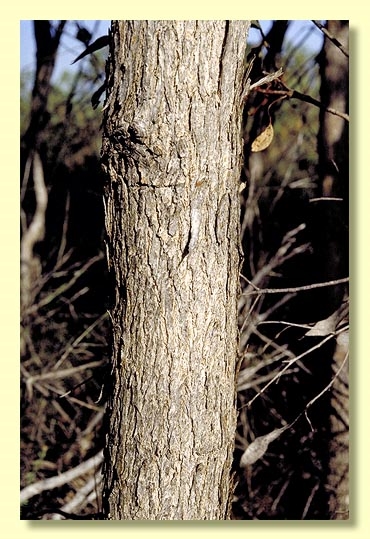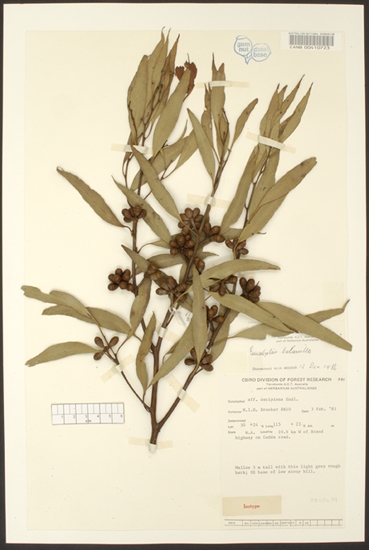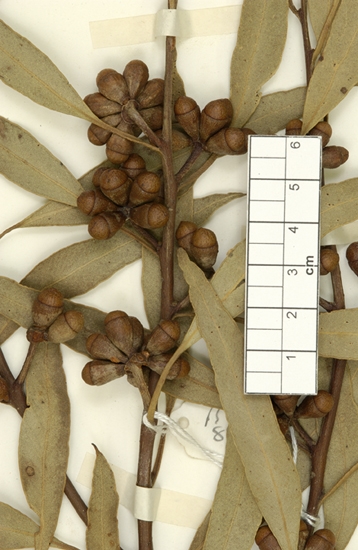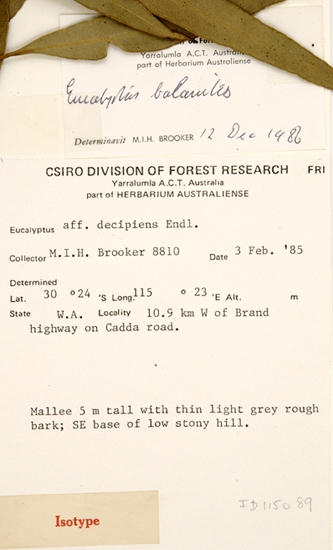Euclid - Online edition
Eucalyptus x balanites
Eucalyptus | Symphyomyrtus | Bisectae | Destitutae |
The x in the above binomial indicates hybrid status and is used here in accordance with Australian Plant Census https://biodiversity.org.au/nsl/services/apc accessed 19 April 2017.
Bark rough to small branches, corky or flaky, grey to grey-brown or grey-yellow, becoming thin and papery on upper stems.
Branchlets lacking oil glands in the pith.
Juvenile growth (coppice or field seedlings to 50 cm): juvenile leaves always petiolate, opposite for few nodes then alternate, elliptical, to 6.5 cm long and 3.5 cm wide, dull, green.
Adult leaves alternate, petioles 1–1.8 cm long; blade usually lanceolate, 6.5–13.5 cm long, 0.9–1.8 cm wide, base tapering to petiole, margin entire, apex pointed, dull to slightly glossy, green, side-veins at less than to greater than 45 ° to the mid-rib, reticulation dense, intramarginal vein close to or remote from margin, oil glands numerous, irregular, intersectional.
Inflorescence axillary unbranched, peduncles 0.7–1.5 cm long, buds 11 per umbel, shortly pedicellate (pedicels 0.1–0.2 cm long). Mature buds ovoid but slightly constricted at the join, 0.8–1.1 cm long, 0.6–0.7 cm wide, hypanthium 2-angled, scar present, operculum rounded to bluntly and broadly conical, stamens inflexed, anthers cuboid, versatile, sub-basifixed, dehiscing by longitudinal slits, style long and straight, stigma blunt to slightly rounded, locules 3 or 4, the placentae each with 4 vertical rows of ovules. Flowers creamy white.
Fruit sessile or scarcely pedicellate (pedicels 0–0.2 cm long), hemispherical or cupular, 0.8–0.9 cm long, 0.8–1.0 cm wide, disc level or scarcely raised and annular, valves 3 or 4, at rim level.
Seeds dark grey to brown, 1–2 mm long, ovoid to flattened-ovoid, dorsal surface smooth but often with a longitudinal furrow, hilum ventral.
Cultivated seedling: cotyledons Y-shaped (bisected); leaves petiolate, opposite for 6 to 10 nodes then alternate, elliptical to oblong, to 4 cm long and 2.5 cm wide, green.
Flowering has been recorded in February, June and July.
A rare erect-stemmed mallee endemic to Western Australia, found on the coastal plain in suburban Perth and from the northern edge of Badgingarra National Park. It has corky or loose rough bark and glossy green leaves. Eucalyptus x balanites
In the classification of Brooker (2000) Eucalyptus balanites is placed in Eucalyptus subgenus Symphyomyrtus section Bisectae subsection Destitutae because buds have two opercula, cotyledons are Y-shaped and branchlets lack oil glands in the pith. Within this sub-subsection E. balanites belongs to a distinctive small group all with shortly stalked or sessile buds in crowded clusters in the leaf axils, crowded fruit and with adult leaves having numerous side-veins, dense reticulation and intersectional oil glands. In this small group (known as series Falcatae subseries Decipientes) there are, according to Brooker, five species, viz. E. decipiens, E. communalis, E. obesa, E. balanites and E. phylacis, but see note below.
E. x balanites differs from the other two rough-barked species in this group, E. decipiens and E. x phylacis, in having larger buds with a very rounded operculum often narrower than the hypanthium giving an acorn appearance when mature. Both E. x balanites and E. x phylacis have flaky to corky rough bark whereas E. decipiens has hard fibrous rough bark. The remaining two species in the group, E. communalis and E. obesa, are smooth-barked mallees. The juvenile leaves of E. x balanites are elliptical, those of E. x phylacis are orbicular to ovate, whilst those of E. decipiens, E. obesa and E. communalis are orbicular to obcordate.
The morphology of E. x balanites suggests that it is a stabilised hybrid of E. decipiens and E. lane-poolei, both of which grow nearby. Seed is rarely set and seed that are plump rarely germinate. [Similarly E. x phylacis is also regarded as a hybrid, see that species for details. E. communalis is regarded as a intergrades or morphological intermediates between E. obesa and E. adesmophloia, details to be found under the latter.]
http://www.environment.gov.au/cgi-bin/sprat/public/sprat.pl















